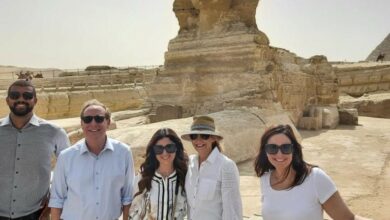A coffee table book, “L’Egypte d’Antan en Couleurs” (Yesterday’s Egypt in Color) is a collaboration between Robert Solé, a major French novelist of Egyptian origins and Max Karkégi, an Egyptian living in France who has, for the past 60 years, amassed an impressive archive of 19th and 20th century Egypt. Published in 2008 by the French publishing house Chêne, this 270-page book is a singularly precious historical document that offers a rich collection of colored postcards of Egypt printed at the eve of the 20th century, offering a bygone vision of Egypt’s major cities and people.
The large selection of colored photographs take the viewer to Egypt as a province of the Ottoman Empire, a Sultanate and finally as a Kingdom. The method used at the time fixed the character’s pose in a static portrayal that, combined with the hand painting technique used to add color, fix the small works somewhere between painting and photography. Karkégi explains that “before World War I, the cost of labor was extremely low, so it was easy to hire someone to color these pictures in watercolor.”
Through the pages of postcards, one observes the motley, cosmopolitan streets of Cairo, Alexandria and Port Said, where white turbans mingle with red tarbushes and derby hats. The local population–Coptic, Muslim and Jewish–live alongside Greek, Armenian, Italian, French and British communities in apparent harmony.
Many postcards display surprising images of the city’s past. One shows the entrance of the Qasr al-Nil bridge, already flanked by two impressive lion statues but without the oppressive car traffic of today. Exiting the bridge is an Englishman wearing an immaculate white suit and pedalling a bicycle, followed by Bedouin merchants and their camels loaded with goods. Another postcard of Ramses Square includes elegant horse drawn-carriages and tramways.
“What is fascinating about these postcards is that they convey a sense of the capital’s extraordinary usability which could never be found anywhere else,” said Karkégi, revealing his passion for the Cairo he knew while growing up in the 40s and 50s.
Karkégi’s family settled in Cairo after his great grandfather, a Greek-Catholic living in Syria, left in the aftermath of Ibrahim Pacha’s conquest of Damascus in 1832. In 1963, Karkégi left Cairo, never to return: “I left like so many other people at the time, because all the doors where closing in front of me,” he said, referring to Nasser’s expropriations.
He began collecting documents, pictures and newspaper articles at the age of 14, after seeing an exhibition entitled "Cairo's Bygone Days” at the Royal Society of Agriculture. “I was thrilled by all the wonderful photos of Cairo, and decided to knock on the doors of all the old people I was acquainted with to ask them for keepsakes, some clippings and some pictures,” he explains.
Most of the postcards in the book were purchased online from all over the world. “The last postcard I bought portrays Qasr al-Nil’s street, and comes from Brasil,” he exclaimed. Ten years ago, Karkégi started his own website (available in French, English and Arabic) devoted to his archive, which has already attracted half-a-million visitors.
Karkégi and Solé’s book is organised in various categories, including Alexandria, Cairo, the Pyramids, the Suez Canal. Two chapters focus on the Egyptian people through portraits and long-gone street businesses. Men, women and children, dressed in exotic outfits, share the frame with accessories readily identifiable with the orient.
Solé explains, in his introduction to the book, “The East had to be orientalized so that it matched the Westerners’ vision of the East.” The discrepancy between the reality of the country and the reality conveyed in the postcards is sometimes extreme. In one, a beautiful young woman poses in front of the camera with a bare torso, at a time when Egyptian women’s bodies were covered from head to toe by a a large, dark fabric called melaya. Another shows a woman wearing a typical Turkish outfit, a voluminous sleeveless cape covering her entire body. Her head and neck is wrapped in a light gauze kerchief, revealing only her eyes.
When asked which category of postcards brings back the most memories from his youth, Karkégi immediately mentioned the small street businesses. The chiffonier that yells “robabekia,” the water carrier with his goatskin bottle on his back, the young tinker in charge of repairing the household’s cookware, and the laundryman who fills his mouth with water to spray the laundry before ironing it, all populate the world of “Yesterday’s Egypt.”
But, in spite of the nostalgia for Egypt his archive displays, Karkégi professes no desire to return to Egypt: “I don’t not want to damage the vision I have of the country. I want to preserve these wonderful memories of mine.”


